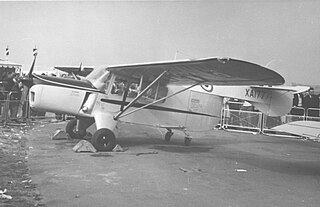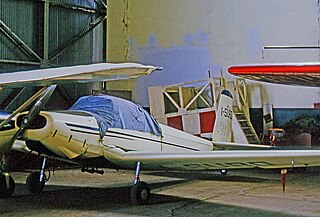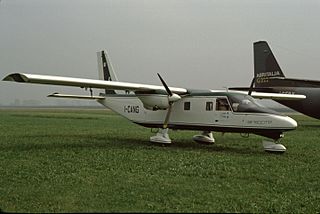
The ICA IS-29 was a sailplane built in Romania in the 1970s. The prefix IS comes from Iosif Șilimon, the Romanian IAR aeronautical engineer who designed it.
The Aeronca Model 9 Arrow was a low-wing all-metal cabin monoplane with retractable landing gear. It was marketed to returning pilots from World War II and unveiled in 1947 but never went into production.

The I-11 was a two-seat civil utility aircraft manufactured in Spain in the 1950s. Originally designed by the Spanish aircraft company Iberavia, its first prototype flew on 16 July 1951. It was a low-wing monoplane of conventional configuration with fixed, tricycle undercarriage and a large, bubble canopy over the two side-by-side seats. Flight characteristics were found to be pleasing, but before plans could be made for mass production, Iberavia was acquired by AISA.

The Piaggio P.166 is an Italian twin-engine pusher-type utility aircraft developed by Piaggio Aero. The aircraft model name was Portofino, and is also known as Albatross in South African military service.
The Auster Avis was a four-seat light aircraft developed from the Auster Autocrat. It featured a redesigned fuselage incorporating four doors and a circular cross-section towards the tail, new undercarriage, and new wing flaps. It was planned in two versions, the Mk 1 for civil use, and the Mk 2 for military and air ambulance duties. However, only two prototypes were built, and Auster abandoned the project in favour of the Auster J-5 Autocar.

The Auster B.4 was an unusual British development of the Auster family of light aircraft in an attempt to create a light cargo aircraft.

The Aviamilano P.19 Scricciolo was a light civil trainer aircraft built in Italy in the 1960s.
The Partenavia P.86 Mosquito was a two-seat civil trainer aircraft first flown in Italy on 27 April 1986. It was a high-wing monoplane of pod-and-boom construction with tricycle undercarriage and a twin tail, that accommodated the student and instructor side-by-side.
The Brochet MB.120 was a two-seat light aircraft developed in France in the 1950s.
The Hindustan Ardhra was a sailplane designed in India for pilot training by the government's Civil Aviation Department in the late 1970s as the ATS-1 Ardhra. It was a two-seat aircraft of conventional configuration and wooden construction. The Indian Air Force ordered fifty examples in the early 1980s to be produced by Hindustan Aeronautics and the type was approved for use for flying by cadets.

The Vulcanair SF.600 Canguro was a feederliner developed in Italy in the late 1970s. Despite a number of attempts to put the aircraft into series production, only a small number were ever built. The Canguro was a high-wing cantilever monoplane of conventional configuration with a fuselage of rectangular cross-section and a high-set tail. The tricycle undercarriage was not retractable, and its main units were carried on sponsons on the fuselage sides. SIAI Marchetti provided funding towards the construction of the prototype, and constructed this aircraft at the former Aviamilano plant. After flight testing proved positive, the type was put on sale, but failed to attract buyers in any number, even when the original piston engines were exchanged for turboprops and retractable undercarriage was offered as an option.

The Macchi MB.308, later Aermacchi MB-308, was a light aircraft produced in Italy in the late 1940s, one of the most prolific Italian-built types of the following decade.
The Grob G 116 was a civil utility aircraft developed in Germany in the late 1980s. It was an enlarged and more powerful four-seat version of the two-seat Grob G 115. Like its predecessor, it was a conventional low-wing cantilever monoplane with fixed tricycle undercarriage. Also like the G 115, construction throughout was of composite materials.

The Hoffmann H40 was a prototype sport aircraft built in Germany in 1988. Designed by Wolf Hoffmann based on his Dimona motor-glider, it was a conventional, low-wing monoplane with side-by-side seating for two and tricycle undercarriage. The aircraft's high aspect ratio wings and T-tail were carried over from its motorglider heritage, but the span was shorter than that of the Dimona. Construction throughout was of composite materials. Hoffmann intended this aircraft to compete with sporting two-seaters such as the Grob G 115 and Robin ATL, but was unable to find the financial backing to bring the aircraft to market, despite a 30% share bought in the project by German pump manufacturer ABS.

The IAR-824 was a utility aircraft built in Romania in the 1970s.

The ICA IS-28 is a two-seat sailplane produced in Romania in the 1970s. An all-metal aircraft of conventional design with a T-tail, it was originally produced with 15-metre wings, but in 1973, production shifted to the IS-28B with 17-metre wings and numerous aerodynamic refinements. These included a smaller tail with decreased dihedral, decreased dihedral on the wings, and redesigned fuselage contours. This version first flew on 26 April 1973 and was subsequently produced in versions with flaps (IS-28B2) and without (IS-28B1). Around 100 had been built by the early 1980s, with a substantial number sold for export. On April 7, 1979, Tom Knauff and R. Tawse set a world record with the IS-28 B2 glider, covering a distance of 829 kilometres on a predetermined out-and-return course from the Ridge Soaring Gliderport in Julian, Pennsylvania.
The ICA IS-32 is an open class high-performance metal two-seat sailplane produced in Romania in the 1970s. A refinement of the IS-28B, it shared most of that aircraft's fuselage, mated to new wings and empennage. This new wing had a span of 20 metres, featuring interconnected ailerons and flaps, Schempp-Hirth-type airbrakes. It had no provision for water ballast. The monowheel undercarriage differed from the IS-28 in being fully retractable.

The SAI KZ IV was a light twin-engined aircraft first built in Denmark in 1944 for use as an air ambulance.

The Valentin Taifun is a two-seat self-launching sailplane designed and built by Valentin Flugzeugbau GmbH of Hasfurt, Germany.

The PZL-126 Mrówka (ant) is a Polish agricultural aircraft first flown in 1990. It is a diminutive low-wing monoplane of conventional if stubby appearance with a cruciform tail, an enclosed cabin and fixed, tricycle undercarriage. Significant parts of the design were undertaken by students at the training college attached to the PZL plant at Okęcie under the direction of Andrzej Słocinski, with the whole project treated initially as a platform for design innovation. Initial design work was completed in 1982 and detail work the following year. Plans to fly a prototype by 1985 were delayed by revisions to the aircraft's equipment, although a mockup was displayed at an agricultural aviation exhibition at Olsztyn that August. Legislation to outlaw certain agricultural chemicals was under consideration in Poland in the late 1980s, spurring interest in biological agents as an alternative and making a tiny aircraft like the Mrówka feasible as a useful piece of agricultural equipment.













